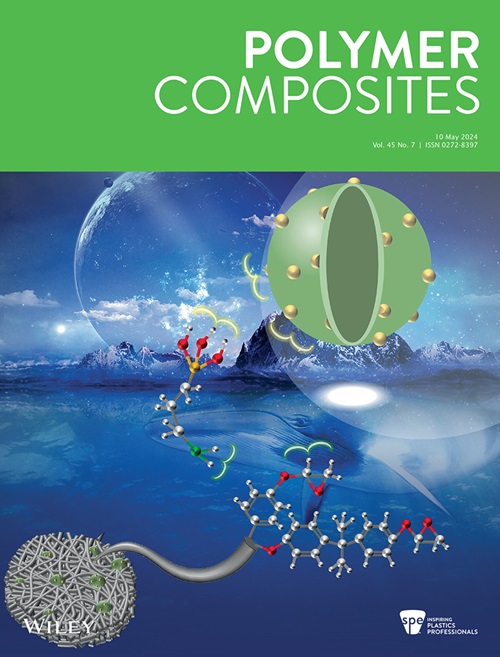Hydrophilic silica transformed silicone rubber into Superhydrophobic composites
IF 4.8
2区 材料科学
Q2 MATERIALS SCIENCE, COMPOSITES
引用次数: 0
Abstract
Abstract Silicone rubber is widely used in medical and equipment manufacturing fields due to its excellent sealing and solvent resistance. However, the hydrophobicity of silicone rubber was unsatisfactory for many advanced engineering structures and applications. Generally, the preparation of artificial superhydrophobic materials suffered from either complicated in process or poor in environmental protection. Here, we reported a simple method to prepare silicone rubber composites with excellent superhydrophobic properties (water contact angle [WCA] = 155.2°) from low‐cost hydrophilic silica. Tests showed that the uniform micro‐nano structures were the key to the superhydrophobic properties of silicone rubber composites. The bounce test observed the rebound of water droplets with different initial velocities (0.77, 1, and 2 m/s) impacting silicone rubber surface, and verified the great advantages of silicone rubber modified by silica in hydrophobic. The modification method shown in this work provides a simple way to manufacture non‐fluorinated, robustness superhydrophobic surfaces for a wide range of potential applications. Highlights Based on the improvement of micro‐nano structure of the matrix surface by industrial silica, the preparation of superhydrophobic silicone rubber composites was realized. A process method for preparing fluorine‐free superhydrophobic silicone rubber composites from hydrophilic silica was proposed. Stretchability and robustness were the key factors for successful superhydrophobic modification of silicone rubber elastomers.亲水二氧化硅将硅橡胶转化为超疏水复合材料
硅橡胶因其优异的密封性和耐溶剂性而广泛应用于医疗和设备制造领域。然而,硅橡胶的疏水性在许多先进的工程结构和应用中并不理想。一般来说,人工超疏水材料的制备要么工艺复杂,要么环保性差。在这里,我们报道了一种简单的方法,用低成本的亲水二氧化硅制备具有优异超疏水性能(水接触角[WCA] = 155.2°)的硅橡胶复合材料。实验表明,均匀的微纳结构是硅橡胶复合材料超疏水性能的关键。弹跳试验观察了不同初始速度(0.77、1、2 m/s)的水滴撞击硅橡胶表面的弹跳,验证了二氧化硅改性硅橡胶在疏水方面的巨大优势。这项工作中显示的修饰方法为制造非氟化,坚固的超疏水表面提供了一种简单的方法,具有广泛的潜在应用。在工业二氧化硅改善基体表面微纳结构的基础上,实现了超疏水硅橡胶复合材料的制备。提出了一种以亲水性二氧化硅为原料制备无氟超疏水硅橡胶复合材料的工艺方法。拉伸性和坚固性是硅橡胶弹性体超疏水改性成功的关键因素。
本文章由计算机程序翻译,如有差异,请以英文原文为准。
求助全文
约1分钟内获得全文
求助全文
来源期刊

Polymer Composites
工程技术-材料科学:复合
CiteScore
7.50
自引率
32.70%
发文量
673
审稿时长
3.1 months
期刊介绍:
Polymer Composites is the engineering and scientific journal serving the fields of reinforced plastics and polymer composites including research, production, processing, and applications. PC brings you the details of developments in this rapidly expanding area of technology long before they are commercial realities.
 求助内容:
求助内容: 应助结果提醒方式:
应助结果提醒方式:


